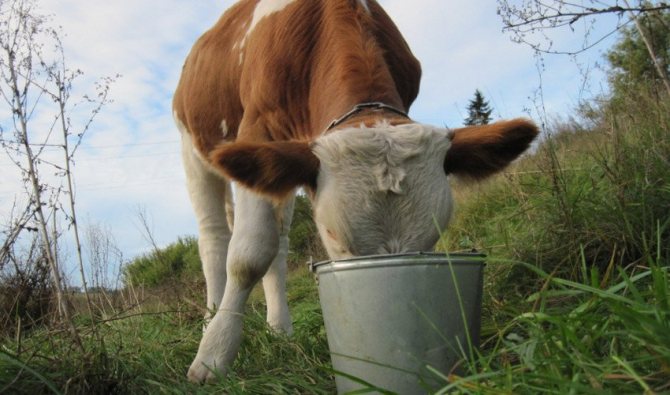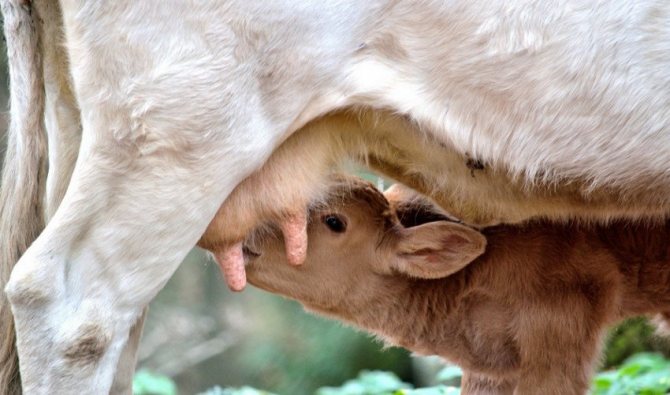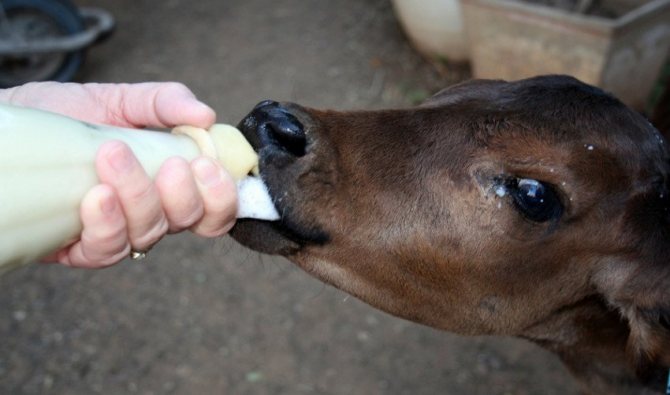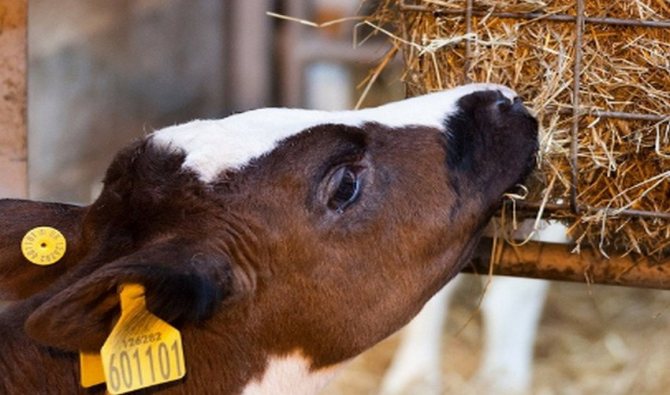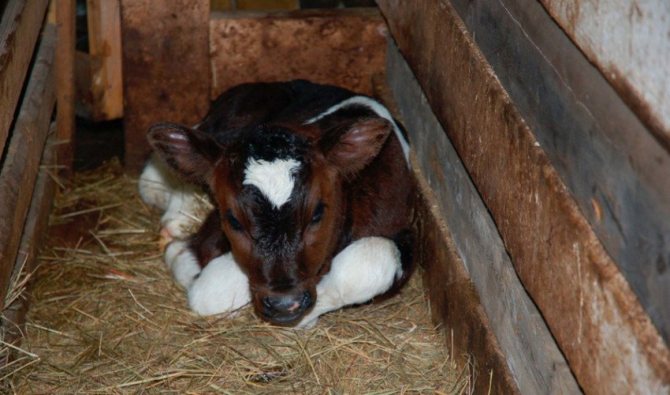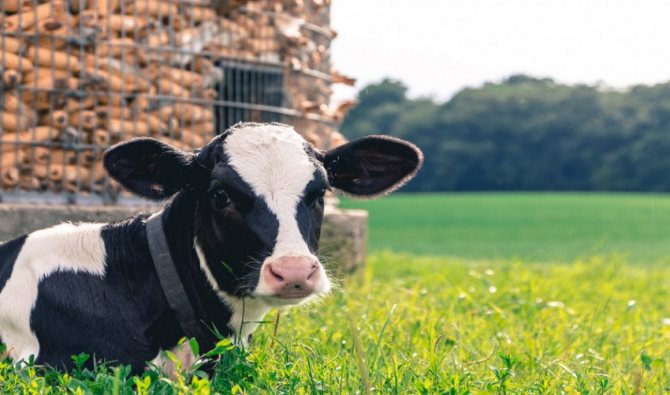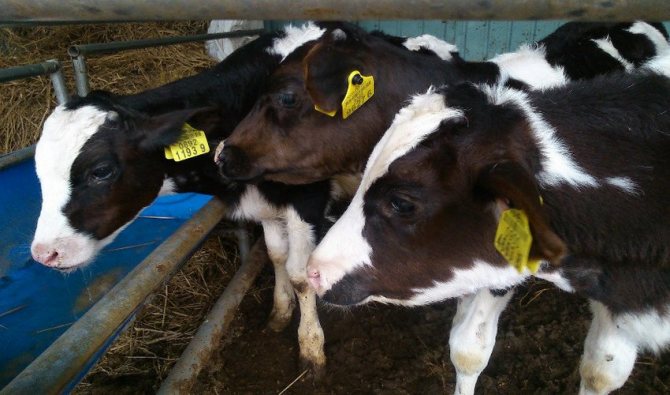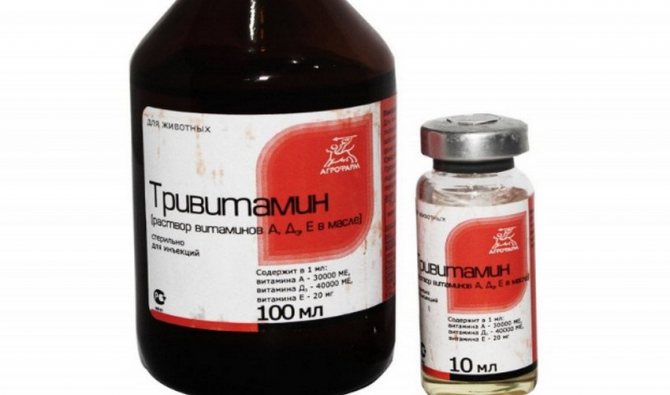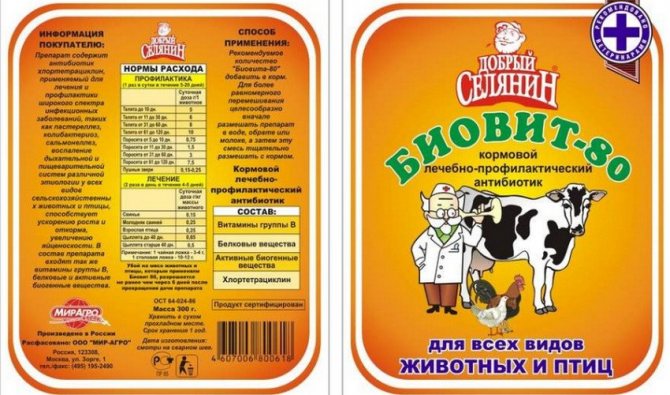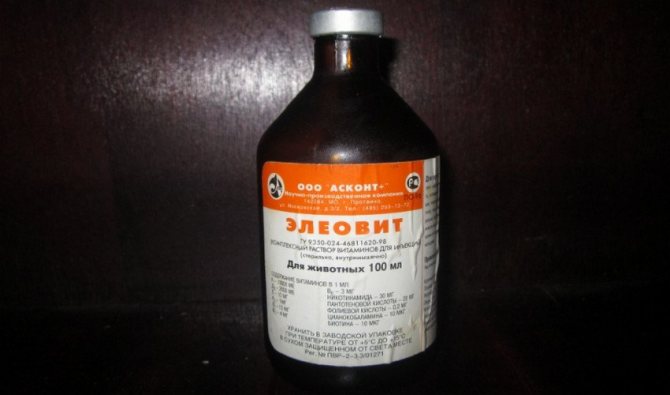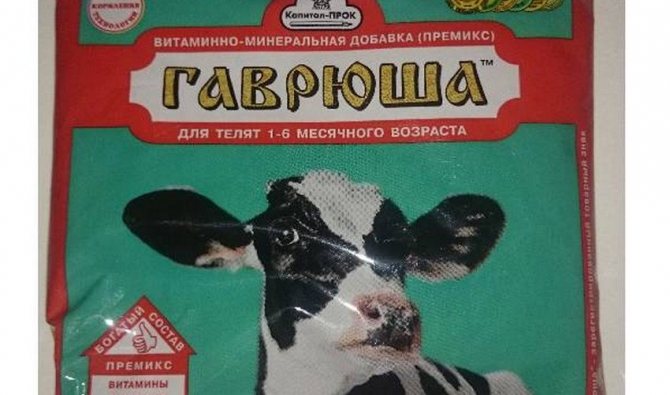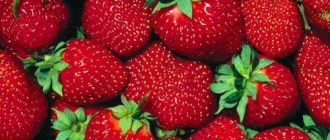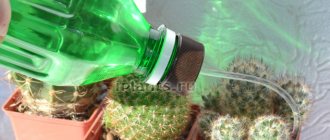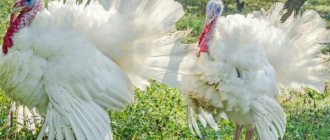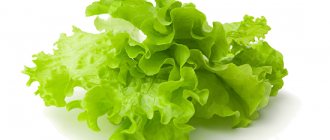Correctly balanced feeding of calves allows you to quickly strengthen the health of the baby, accelerate its growth, and also lay the foundation for future high productivity. Therefore, before taking on the preparation of a diet for young animals, it is important to deepen your knowledge of this topic. And the basic nuances of calf feeding can be found in this article.
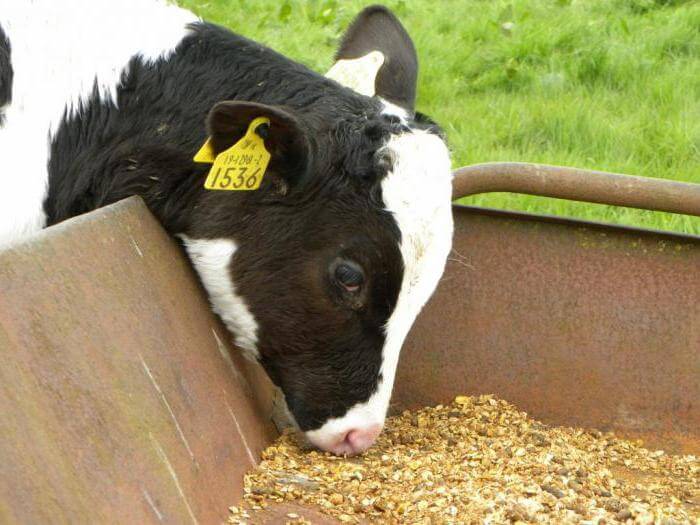
Feeding calves
How to feed newborn calves
Feeding of newborn calves is realized exclusively on the basis of mother's colostrum. In the first 7 days of an animal's life, it acts as the only food source for the baby. Moreover, it is extremely important to provide the offspring with an abundant amount of colostrum on the day of calving. The calf is applied to the udder of the cow within the first hour after birth. This will reduce the likelihood of diseases in the baby by 70% and, accordingly, increase the survival rate.
Colostrum of a cow in the first days after calving is characterized by an extremely high content of nutrients, minerals and vitamins. Its consumption contributes to the accelerated development and growth of the calf. But, despite this, it is necessary to clearly control the volume of milk consumed by animals. For the first feeding, the calf should consume no more than 6% of its weight of colostrum. In this case, the daily food intake should not exceed 20% of the body weight of the offspring on the first day. In the future, it can be increased to 24%.
As for the frequency of feeding, at the initial stage of development, the baby should eat at least 6 times a day. By the age of 14 days and further, the number of feedings is gradually reduced to 3. At the same time, both drinking and sucking feeding methods can be used.
The first technology is most widespread in livestock farms and is practiced during the first 3 weeks of a baby's life. This method involves the use of special drinkers with a teat, into which colostrum is poured. Before serving, food is heated to a temperature of 37 degrees.
The sucking method consists in feeding the calf directly from the mother's udder. It assumes the following advantages:
- the risk of disease in young animals decreases;
- the mixture is already ready for use by the calf and does not require additional heating and other manipulations;
- the calf eats food in small portions, which promotes better absorption;
- the growth rate of young animals increases by 30%.
Before implementing suckling, it is important to thoroughly clean the udder of the cow to avoid infection of the calf. This feeding method is used up to the 5th day of the animal's life.
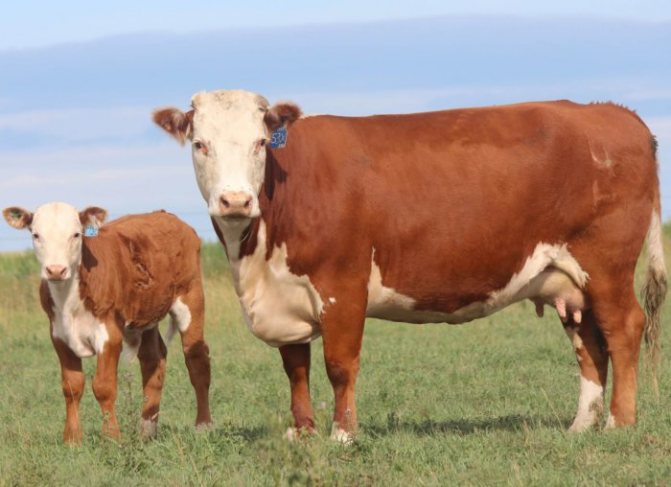

Blood and calf before feeding
In some cases, the cow may not have enough colostrum to properly feed the baby. In this case, you can make your own calf feed. To do this, thoroughly mix in a clean container:
- cow's milk - 1l;
- chicken eggs - 4 pcs;
- fish oil - 15 g;
- table salt - 3-4 g.
Attention! It is necessary to feed the baby with this mixture at a dosage of 1 liter. Meals are taken at a strictly set time every 3-5 hours.
Important Tips
If the cow does not have enough colostrum, you can also use semolina. It saturates the calf's body much faster. Such a composition is being prepared, based on the proportion: 4 tablespoons of cereal for every 3 liters of milk.
From the 6th day after calving, the baby needs to be provided with access to an abundant amount of water. Lack of fluid will reduce the absorption of nutrients in the body, which in turn will slow down the growth and development of the calf. At first, to ensure the optimal amount of fluid in the body, the baby is given 1 liter of warm (35-37 degrees) boiled water 2 hours after feeding. Starting from the 3rd week, large quantities of water are simply poured into the drinkers. If desired, ordinary water can be replaced with hay or coniferous infusion.
At 6-7 days of age, the calf can be gradually trained to hay. To do this, take fresh, dried herbs, from which all coarse and dry parts are pre-selected. Then the bundle is tied to the elements of the stall (10 cm above the back of the animal) or placed in a trough.
Hay at this age contributes to the proper formation of the digestive system. But it should be introduced into the diet gradually. Feeding begins with a small portion, which is constantly increased, reaching 1.5 kg by 3 months.
Other feeds are introduced into the diet according to the following schedule:
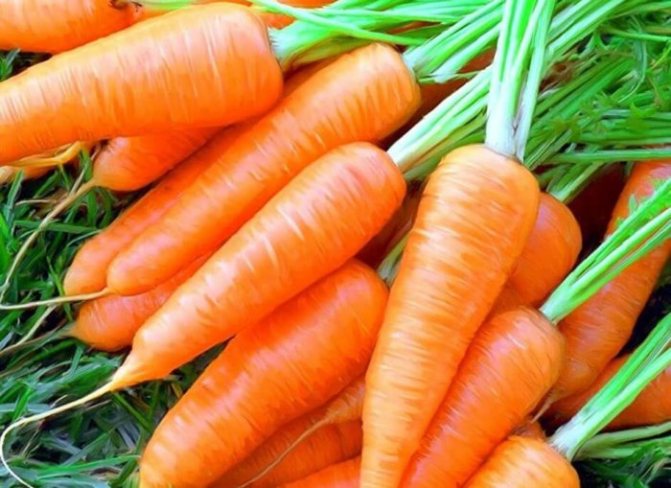

Carrots can be given from 15-17 days
- concentrates and combined feed - from two weeks of age;
- carrots - from 15-17 days;
- boiled potatoes and boiled apples - for 20-21 days;
- chalk and table salt - from 21 days;
- fodder beets are introduced into the diet of monthly calves.
Walking
Systematic walks are very important in the life of calves. They begin to accustom the calf to walking from 15-20 days of age, releasing it daily for 20 minutes. Walking time is gradually increased, and it is brought up to 2 hours in winter, and on sunny and warm days even for a longer time. For walking near the farmyard, an area of 10-12 square meters is fenced off for each baby. The pen provides a feeder for hay or green mass.
It is not recommended to drive calves to pasture in a common herd due to the danger of infection with helminthic diseases.
Walking yards and cages are cleaned at least 2-3 times a day, the litter is replaced as needed. In addition, wooden walls and gratings are whitewashed with fresh lime at least once a week.
Calf feeding from 1 to 3 months
The calf at the age of one month is still being taught to different feeds. The basis of his diet during this period will be chopped hay, which is mixed with grated beets, carrots, apples and potato skins. Concentrates are used as top dressing.
It is extremely important during this period of the baby's development to maintain the cleanliness of his feeder and the place of detention in general. All food debris is removed from the trough immediately after the end of the meal, and the container itself is thoroughly washed out. Stale food is bound to cause digestive problems.
But it is worth remembering that it will not be possible to fully provide the necessary norms for feeding monthly calves with hay and vegetables. The animal still needs dairy food. Therefore, in addition to the main diet, top dressing is used, which is prepared from the following components:
- milk - 1 l;
- meat and bone meal - 10 g;
- chalk - 10 g;
- table salt - 10 g.
Such a composition will make up for the lack of vitamins, calcium and phosphorus in the body. It is also useful to add 4-6 liters of return to the calf menu.
2-3 months
When the calf reaches 2 months, its diet is adjusted again. The amount of concentrated feed increases. In addition to oats, wheat and barley, it is already possible to introduce small portions of cake and bran into food.
Good weight gain can be achieved if specialized feed is used during this period. Do not stop giving feedback at this time.
Succulent feed is also an essential part of the diet.Moreover, calves born in the summer, in addition to vegetables, can already be fed dried grass from pastures in small portions, gradually increasing its volume.
Hay is added in an amount of 1 kg per day. Moreover, it is advisable to soak it in a saline solution before serving. This will minimize the likelihood of parasites in the intestines.
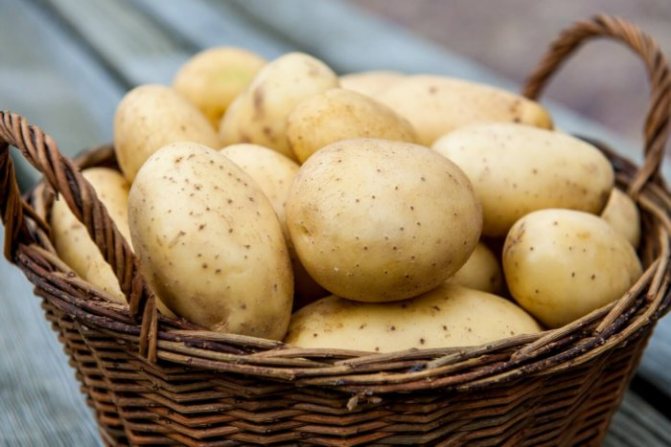

Potatoes are a good source of vitamins.
To ensure the proper mineral and vitamin balance, appropriate purchased complexes are also introduced into food. A good source of vitamins is potatoes, which are fed raw to calves at 250 g per head per day. You can also add chalk and salt to the feed.
Possible problems
The body of young animals can undergo various infections, since it has not yet been fully formed. Some diseases require a quarantine regime. Below we will consider the most common diseases.
Cough
Coughs can be caused by being in a cold, draft room, high humidity, or lack of bedding. Also, a cough in a calf may indicate the appearance of various diseases associated with the respiratory system. During the weaning of calves from the mother, after castration and during the period of group housing, the immunity of the young is reduced. Individuals aged 1–2 years are less likely to suffer from diseases of the respiratory system, but these diseases occur with complications.
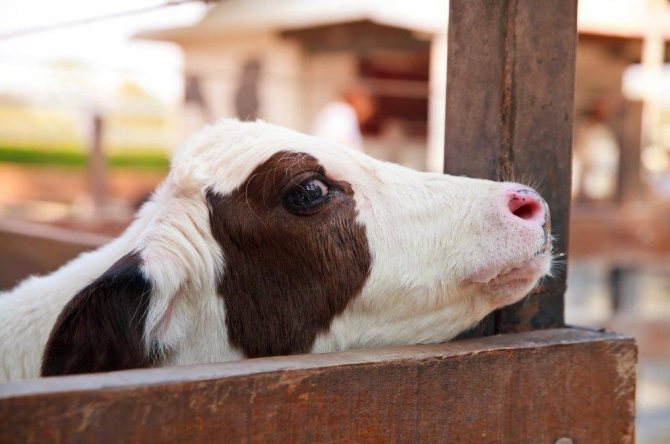

Diarrhea
There may be several causes of diarrhea in calves:
- unformed organism;
- improperly organized feeding ration;
- infectious diseases.
With diarrhea, the most dangerous symptom is dehydration, since the disease is accompanied by profuse discharge. Concomitant indicators of diarrhea in a calf include drooping eyes, feeling unwell, dry skin, bloody discharge, and decreased activity.
Learn about the causes of diarrhea in calves.
Dyspepsia
Dyspepsia is indigestion. Previously, the term was considered a sign of the development of various infections, but over time it was included in the list of diseases of the digestive system. Dyspepsia occurs in mild and severe forms. Indigestion most often occurs during lactation.
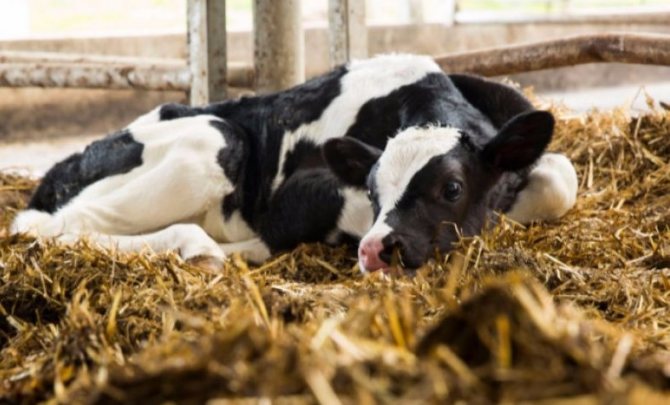

The main characteristics of the disease are diarrhea, toxicosis, digestive upset, and dehydration. Dyspepsia is a year-round disease, the peak of the disease occurs at the end of winter - early spring. Also, this disease can affect 100% of young animals, which leads to the death of the entire livestock.
Did you know? Dyspepsia is popularly referred to as "newborn diarrhea" or "enzymatic diarrhea."
Bronchopneumonia
Bronchopneumonia is a chronic lung disease. The disease is characterized by severe coughing, poor animal health, slow breathing, and nasal discharge. Bronchopneumonia affects livestock en masse.
The main causes of the disease are:
- lack of walking the animal in the fresh air;
- high humidity in the room;
- the presence of drafts in the calf barn, low temperature of keeping;
- high room temperature in the presence of dry air;
- insufficient amount of vitamins in the diet of calves.
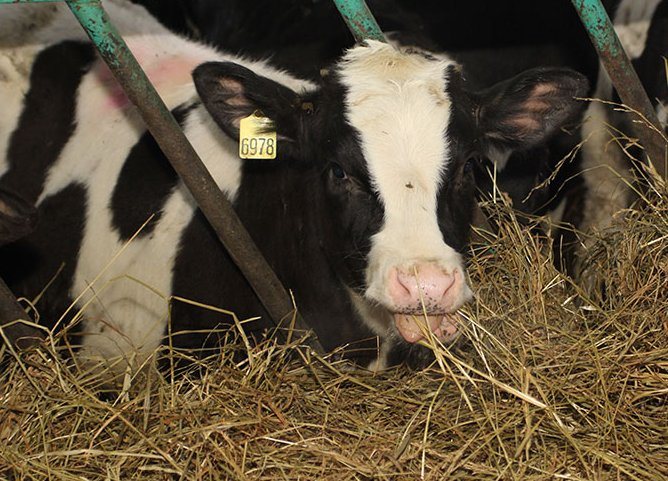

Salmonellosis
Salmonellosis is a disease caused by the bacteria Salmonella. In most cases, it affects calves 10–12 months old. Most often, the disease develops in winter. The main reason for the occurrence is the keeping of young animals in unsanitary conditions. Also, this disease can be transmitted from one individual to another. There are mild and severe forms of salmonellosis.
Learn more about the symptoms and treatment of salmonellosis in calves.
The main symptoms are:
- lethargy of the animal;
- discharge from the nose;
- increased body temperature - + 39–40 ° С;
- lack of appetite;
- the presence of diarrhea.
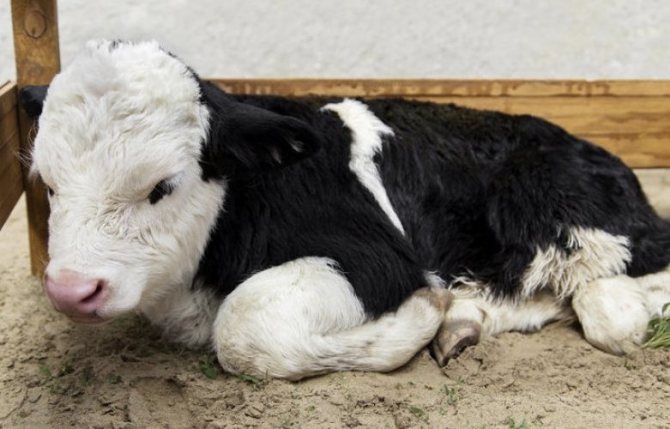

To cure young animals, you need to isolate sick individuals and contact a veterinarian. Raising calves at home requires special care. Correctly selected technologies for their maintenance and feeding will help prevent the occurrence of various diseases.
Calf diet from 3 to 6 months
By the age of 3 months, the amount of milk in the calf's menu is gradually reduced, and it is completely stopped by six months. During this period, the approximate daily diet of the animal is as follows:
- 1-1.5 kg of combined feed;
- 1.5 kg of beets and potatoes;
- 1.5 kg of hay;
- 1.5 kg of silage;
- 5 liters of skim milk.
Of course, this pattern may vary depending on calf weight, housing conditions and the intended use of the livestock. If this feeding period fell in the summertime, then the indicated volume of hay is better to replace with 2 kg of fresh grass. For this, the calf is driven out to the pasture. The main thing is that it has several shaded areas and a source of clean water.
If the livestock owner has access to free pasture, then fresh grass can be the basis of the entire diet, and concentrated feed and vegetables can be used only as top dressing. In this case, the daily amount of grass for a 3 month old calf will be 10 kg. By 6 months, it must be gradually increased to 20 kg.
The use of vitamin supplements
Vitamins play one of the key roles in the growth and development of young cattle. But it is not always possible to replenish their reserves in the body only at the expense of food. So, for example, in winter and early spring, the body requires a lot of vitamins, and their absence can lead to the development of various diseases. During this period, it is advisable to supplement food with vitamin complexes.
An effective remedy in this direction is the drug "Trivitamin". 4-5 drops of this composition are added to the feed for the calves in accordance with the instructions. Biovit-80 and Eleovit also have a similar effect on the baby's body. Such funds are introduced into the animal's diet from the 3rd week.
Also, the optimal source of vitamins for livestock are the preparations "Gavryusha" and "Nucleopeptide". But unlike the previously indicated formulations, such additives are administered intramuscularly to animals.
It is better to use any vitamin complexes and various supplements after consulting a veterinarian. Otherwise, animals may develop hypervitaminosis, which is also harmful to the body.
Among the folk remedies that make it possible to replenish the reserves of calf vitamins, the infusion of needles is especially popular. Prepare it as follows:
- In a large saucepan, spread 1 kg of needles (spruce or pine), which are previously separated from the branch itself.
- Add 5 liters of hot water to the same container.
- The resulting composition is brought to a boil, after which the heat is reduced to minimum and boiled for half an hour.
- After the infusion has cooled completely, all the needles are taken out, transferred to gauze and carefully squeezed the juice back into the container.
The resulting vitamin drink is given to calves from 2 weeks of age. Before serving, it is slightly warmed up and a small amount of salt is diluted in it. One portion of the infusion for an animal is 50 g per day. By 2 months, it is gradually increased to 1 liter.
In summer, young animals will be content with vitamins, which they consume with grass and vegetables. Therefore, at this time, there is no need to provide it with additional vitamin complexes.
Of course, it is not necessary to take into account all these points when feeding young cattle. But in this case, the animals often show deterioration in health, a drop in productivity, and a high mortality rate of young animals. And only a properly composed and balanced diet will avoid such problems, which promise considerable economic damage to farms.
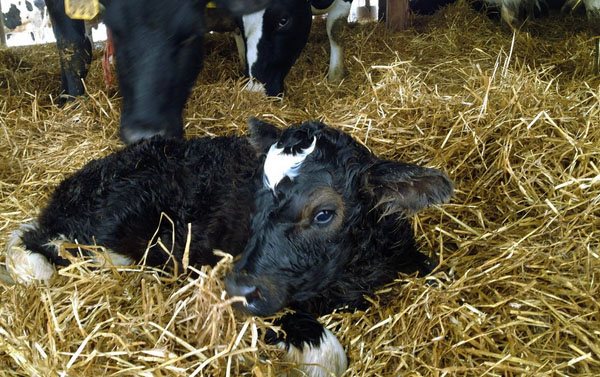

In the first days of life, a calf is vulnerable to any disease, since its blood contains a small number of immune bodies capable of destroying viruses and bacteria. Therefore, it depends on the quality of care and feeding of calves up to 3 months how quickly and healthy they grow up. They are kept only in clean, dry and ventilated cages, but without constant drafts. Calf feed should be high in protein, vitamins and minerals.
Food for newborn calves must have a high energy value and be easy to digest.
Feeding the young after 6 months
At the end of the post-milk period, the diet for animals is selected especially carefully. In this case, it is based not only on the physiological needs of the body, but also on the intended purpose of the livestock.
So, in the case of beef feeding, a six-month-old bull for a day needs:
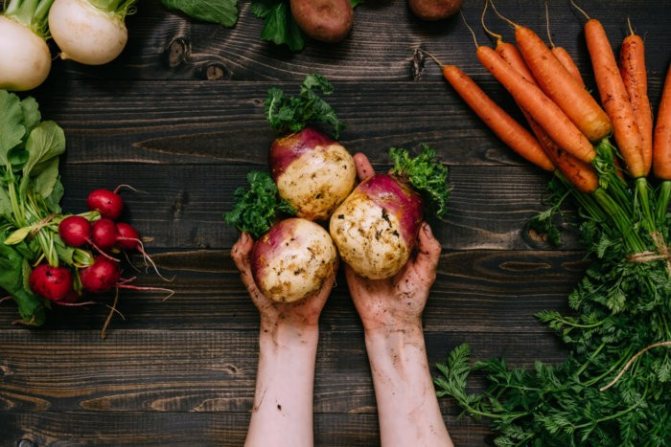

Root vegetables for calves
- 8 kg of chopped root vegetables and vegetables;
- 5 kg of compound feed;
- 3 kg of hay;
- plenty of fresh grass from the pasture.
Important! These norms are gradually increased every month. So, the volume of vegetables fed by 10 months should already be 12 kg.
Also, free access to clean water is still extremely important.
If these rules are observed in feeding, starting from 6 months, calves should give a gain of 700-900 g. This is the main sign of the effectiveness of the selected feeding program. Also, the presence of appetite in young animals and high activity testify to the correct choice of diet.
If growth is not observed for a long time, and the animal becomes lethargic and eats worse, it is assigned to a separate group of calves. There they are examined by a veterinarian, and in the absence of diseases, the young are transferred to a special enhanced nutrition.
Be sure to take into account the age-related need for minerals and vitamins. Feed should be selected in such a way that 1 energy feed unit accounts for:
- 8 g calcium;
- 6-7 g table salt;
- 5 g phosphorus;
- 30 mg carotene;
- 50 mg vitamin E.
More precisely, the diet is planned based on the physiological characteristics of a particular animal. Feeding efficiency is measured by the weight of a one-year-old calf. Normally, it should be at least 50% of the mass of adult livestock.
Care rules
Full-fledged rearing of young animals includes not only balanced nutrition, but also competent care from the moment of birth:
- Immediately after birth, the umbilical cord is cut off to the animal with sterile scissors. The cut sites are watered with iodine to eliminate the risk of infection. The newborn is placed next to the mother, who must lick it. This will help keep him warm. If the cow does not do this, it is worth removing the remnants of the placenta herself using any tissue.
- The place for keeping the animal should be prepared in advance. The shed or cage is disinfected, a straw bedding is placed on the bottom. The optimum temperature for keeping the calf is 14-16 °.
- To facilitate the care of the young, it is worth accustoming him to a certain feeding time in the first days. All liquid feed is given warm (34-36 °).
- Up to 1 month, the calf is kept separate from the general herd of young animals. Do not allow monthly animals to approach adults - cows and gobies. It is allowed to keep heterosexual young animals in one pen for up to six months.
- It is worth regularly cleaning the cage or shed and changing the litter.
():
Feeding and caring for the calves plays a very important role in raising livestock. According to statistics, one out of five calves dies or is seriously ill during the first year of life. Poor maintenance and unsatisfactory feeding are the main reasons for the ill health of young animals.
Concentrates, juicy feed and vitamin supplements
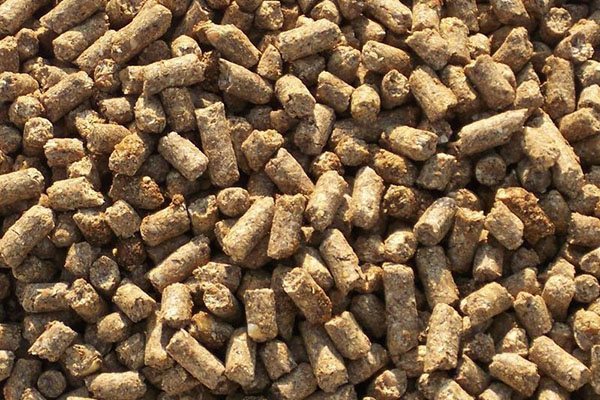

Concentrated feed is given to calves that are two weeks old. Sifted oatmeal is the most commonly used as it is easy to digest.Or they buy starter feed, since it, in comparison with oatmeal, contains all the vitamins, minerals and other useful elements necessary for the healthy growth of the animal. You can make a combined mixture with your own hands. The basis will be oats, wheat, corn and barley. Also adds sunflower meal, fish meal, feed yeast, grass meal, salt, chalk, phosphates and vitamins.
Salt and chalk is given to calves that are three weeks old. In the first month of life, you can also feed whole grains of oats or barley. Thanks to this, the stomach and chewing muscles develop faster. Do not forget about juicy food. They can be dispensed to calves from three weeks of age. Boiled potatoes (mashed potatoes), grated carrots are added to the milk, and when 4 weeks old, you can start giving out fodder beets.
When grooming and feeding calves, hygiene and cleanliness must always be followed. After each feeding, the containers are thoroughly washed and scalded with boiling water. This will minimize the likelihood of intestinal diseases.
The greatest number of diseases occurs due to a lack of vitamins, therefore, it is always necessary to give the calves vitamin preparations. The main thing is, before adding them to the feed, carefully study the instructions and observe the indicated dosages. From 1 month old, you can feed the animals with Felucene for calves. This energy supplement comes in the form of granules, contains amino acids, minerals, a complex of vitamins, as well as fats and carbohydrates.
Using one vitamin supplement, in no case should others be given out.
How to choose milk replacer?
Given the wide range of whole milk substitutes, it is very important to choose a really high quality product. It is worth noting that today on the modern market there are many varieties of milk replacer for calves of various age groups, which in their biochemical composition are practically in no way inferior to whole milk and at the same time have a lower cost.
Depending on the consistency, milk replacer is classified into three groups:
- liquid, ready to use;
- concentrated. Before feeding, it must be diluted with water or milk whey;
- dry. They are diluted with liquid in a ratio of 1/8.
It is more convenient and best of all to use dry milk replacer for feeding calves, since powder mixtures have a longer shelf life and practically do not differ in composition from natural milk.
Low-quality, low-grade substitutes may contain unprocessed soy flour, which can provoke acute diarrhea and indigestion. They are low cost but completely unsuitable for feeding small calves. Therefore, before purchasing milk replacer, we recommend that you consult with veterinarians, experienced farmers.
Feeding calves milk replacer
According to experienced farmers, the following whole milk substitutes have worked well:
- Kalvolak.
- Kalvomilk.
- Goodmilk.
- Eurolac.
- Prodlak.
Such products have a high nutritional and energy value, contain components necessary for the growth and development of young animals, and are an excellent alternative to whole milk. The instructions for using milk replacer for a calf will tell you how and in what proportions you need to dilute the dry powder mixture.
When feeding calves with milk mixture, you can use domestic products or foreign counterparts that contain high-quality whey proteins. They can be fed to a calf from 5 days of age.
Colostrum
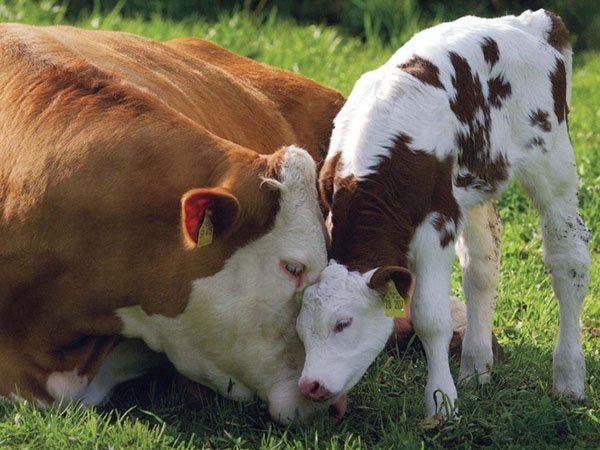

After the calf is born, it must be fed with colostrum for half an hour or an hour. This will reduce the likelihood of diseases by 70%, since the first milk after birth contains a high concentration of proteins, carbohydrates, fats, minerals and vitamins, as well as immune globulins and antibodies.Unlike ordinary milk, colostrum contains 2 times more dry matter, therefore it has a high energy value.
When calves are fed with colostrum, due to the large amount of magnesium salts in it and high acidity, the intestines are cleared of meconium (original feces).
If you do not feed the calf within an hour after birth, then he will begin to suck on the surrounding objects. Because of what it can get sick with dangerous diseases, which in turn will lead to the death of the animal.
The first portion is calculated so that it is 4 to 6% of the total calf weight. But no more than 20% per day, and 24% on the following days. Do not give too much colostrum as it will upset your bowels. If the calf is weak, then it is better to feed it in small portions (0.5-0.7 liters), but more often - up to 6 times a day. The average daily feeding rate is 8 liters.
Colostrum temperature should be around + 37 ° C. Cold milk will cause intestinal upset.
It is recommended to feed calves from teat drinkers up to three weeks of age.
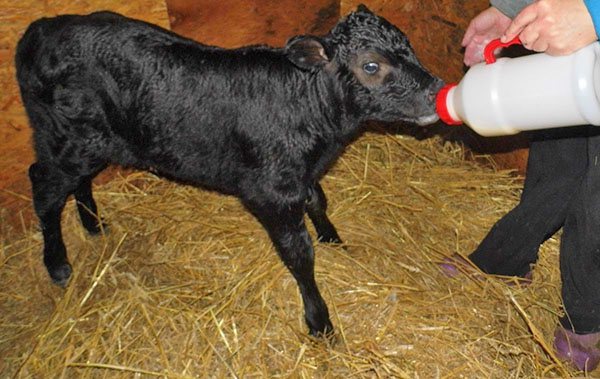

You can also drink with the suction method. It has the following advantages:
- milk comes in small portions, which is extremely important when raising calves with not yet fully developed stomachs;
- food is always clean and warm, as a result it is better absorbed;
- the level of immunoglobulins rises faster;
- the risk of disease is noticeably reduced;
- weight gain increases by 30%.
Sucking can be fed for up to 5 days.
Before feeding the calf in this way, the udder of the cow must be thoroughly cleaned.
What to do if there is no colostrum
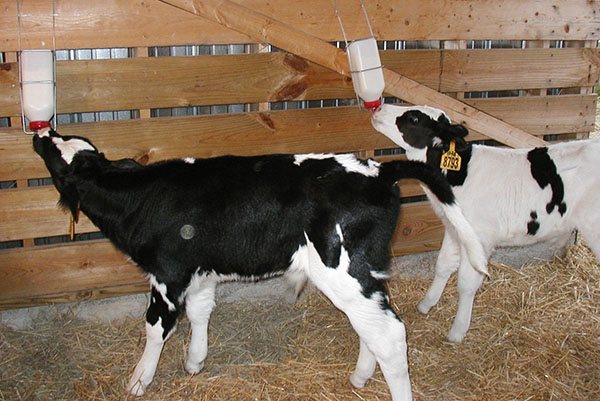

If there is no colostrum or the risk of disease is increased when feeding it, then the calf is fed with the same milk from another cow or do it yourself. To do this, add 15 ml of fortified fish oil, 5 g of salt and 3 fresh eggs to 1 liter of fresh milk taken from a fresh cow. Mix everything thoroughly until smooth. A newly born calf is given 1 liter of the mixture, and for the next feedings it is diluted with boiled water by 50%.
Newborn calves are fed every 3-5 hours 4-5 times a day. In this case, the period of time after milking the cow and feeding should be minimal, since every hour more bacteria appear in the milk, which inhibit digestion.

